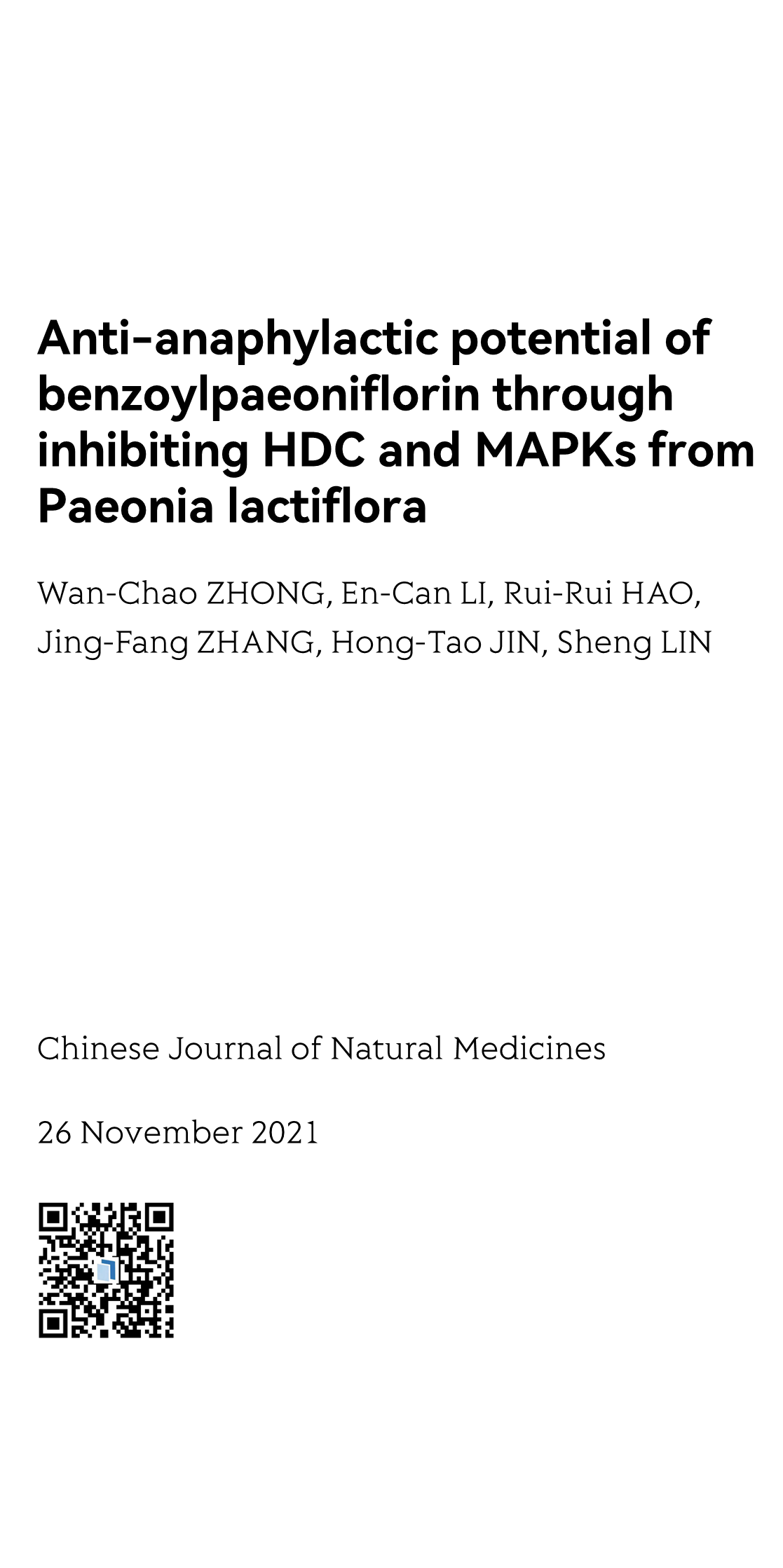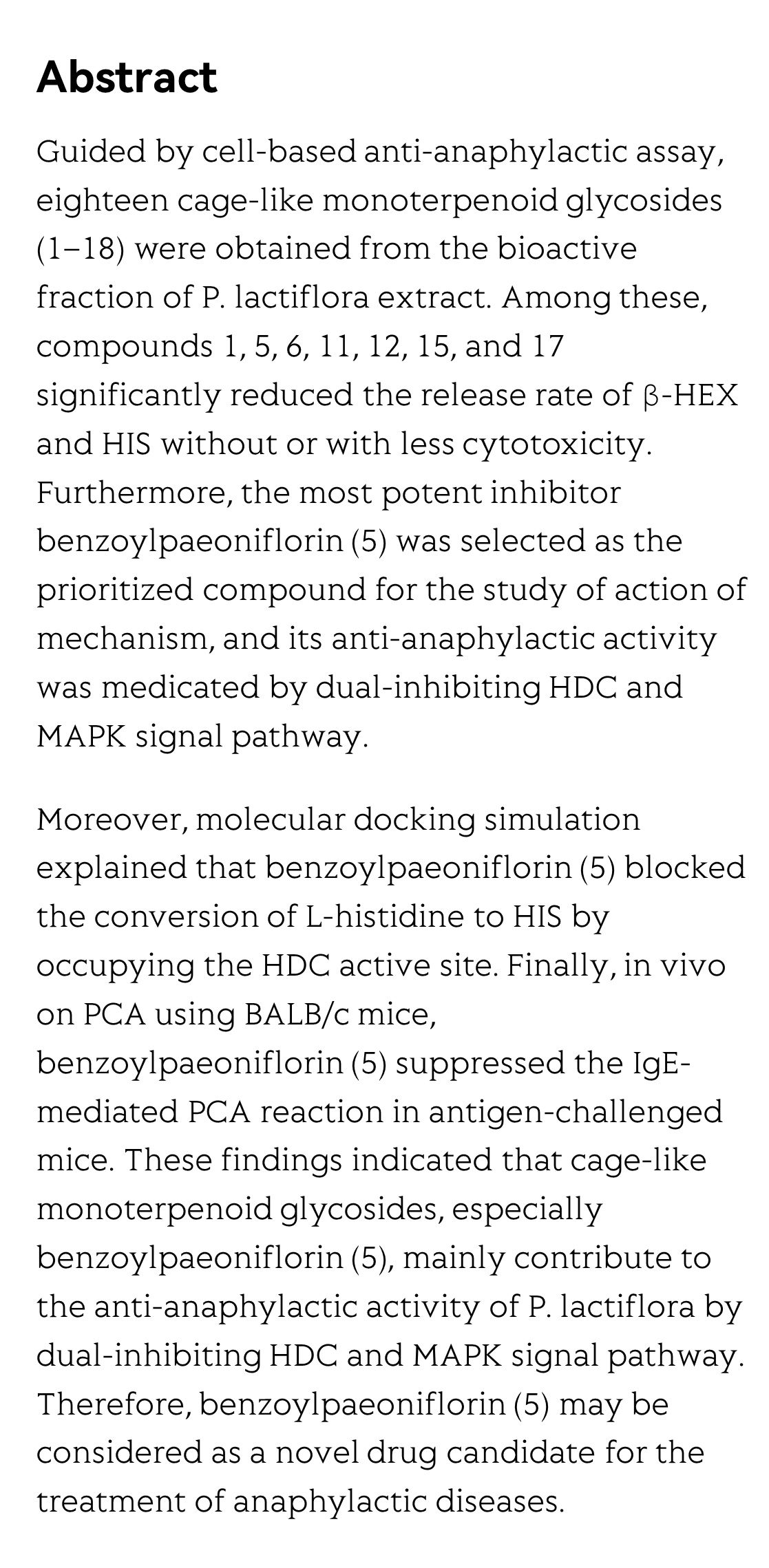(Peer-Reviewed) Anti-anaphylactic potential of benzoylpaeoniflorin through inhibiting HDC and MAPKs from Paeonia lactiflora
Wan-Chao ZHONG 钟万超 ¹, En-Can LI 李恩灿 ², Rui-Rui HAO 郝瑞瑞 ², Jing-Fang ZHANG 张景芳 ¹, Hong-Tao JIN 靳洪涛 ² ³, Sheng LIN 林生 ¹ ⁴
¹ State Key Laboratory of Bioactive Substance and Function of Natural Medicines, Institute of Materia Medica, Chinese Academy of Medical Sciences & Peking Union Medical College, Beijing 100050, China
中国 北京 中国医学科学院北京协和医学院药物研究所 天然药物活性组分与药效国家重点实验室
² New Drug Safety Evaluation Center, Institute of Materia Medica, Chinese Academy of Medical Sciences & Peking Union Medical College, Beijing 100050, China
中国 北京 中国医学科学院北京协和医学院药物研究所 新药安全评价研究中心
³ Beijing Union-Genius Pharmaceutical Technology Co., Ltd., Beijing 100176, China
中国 北京 北京协和建昊医药技术开发有限责任公司
⁴ Key Laboratory of Chinese Internal Medicine of Ministry of Education and Beijing, Dongzhimen Hospital, Beijing University of Chinese Medicine, Beijing 100700, China
中国 北京 北京中医药大学东直门医院 中医内科学教育部重点实验室
ABSTRACT
Guided by cell-based anti-anaphylactic assay, eighteen cage-like monoterpenoid glycosides (1–18) were obtained from the bioactive fraction of P. lactiflora extract. Among these, compounds 1, 5, 6, 11, 12, 15, and 17 significantly reduced the release rate of β-HEX and HIS without or with less cytotoxicity. Furthermore, the most potent inhibitor benzoylpaeoniflorin (5) was selected as the prioritized compound for the study of action of mechanism, and its anti-anaphylactic activity was medicated by dual-inhibiting HDC and MAPK signal pathway.
Moreover, molecular docking simulation explained that benzoylpaeoniflorin (5) blocked the conversion of L-histidine to HIS by occupying the HDC active site. Finally, in vivo on PCA using BALB/c mice, benzoylpaeoniflorin (5) suppressed the IgE-mediated PCA reaction in antigen-challenged mice. These findings indicated that cage-like monoterpenoid glycosides, especially benzoylpaeoniflorin (5), mainly contribute to the anti-anaphylactic activity of P. lactiflora by dual-inhibiting HDC and MAPK signal pathway. Therefore, benzoylpaeoniflorin (5) may be considered as a novel drug candidate for the treatment of anaphylactic diseases.
Flicker minimization in power-saving displays enabled by measurement of difference in flexoelectric coefficients and displacement-current in positive dielectric anisotropy liquid crystals
Junho Jung, HaYoung Jung, GyuRi Choi, HanByeol Park, Sun-Mi Park, Ki-Sun Kwon, Heui-Seok Jin, Dong-Jin Lee, Hoon Jeong, JeongKi Park, Byeong Koo Kim, Seung Hee Lee, MinSu Kim
Opto-Electronic Advances
2025-09-25
Dual-frequency angular-multiplexed fringe projection profilometry with deep learning: breaking hardware limits for ultra-high-speed 3D imaging
Wenwu Chen, Yifan Liu, Shijie Feng, Wei Yin, Jiaming Qian, Yixuan Li, Hang Zhang, Maciej Trusiak, Malgorzata Kujawinska, Qian Chen, Chao Zuo
Opto-Electronic Advances
2025-09-25



